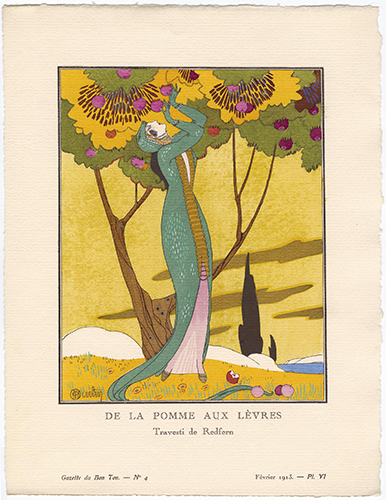Fashion of the 1910s: Charles Martin
I have always been fascinated by the evolution of fashion and how it impacts our lives, and the lives of people in the past. Having studied the history of fashion, it is quite easy for me to sometimes date undated paintings simply by what the people in the painting are wearing. One of the easiest periods to date is that around the time of the Titanic sinking (1912).
 |
| Charles Martin (1884–1934, France), Dress by Redfern, from Gazette du Bon Ton, February 1913. Photomechanical lithograph with applied color, 10" x 7 ½" (25.4 x 19.1 cm). © Museum of Fine Arts, Boston. (MFAB-589) |
Have you ever had your students try their hand at fashion design? Many non-Western cultures have influenced Western fashion. What cultures do you think would have an interesting impact on western dress? Can you point out non-western influences in fashion in the last 20 years?
DID YOU KNOW that at that time women’s fashions were greatly influenced by fashion designer’s perceptions of what was “Oriental,” i.e. from the Arab world? This came about during the first decade of the 1900s because of the wild popularity in Paris of the Ballet Russes, formerly the Imperial Russian Ballet. The most popular ballet they performed was Shéhérazade, (1910) by Rimsky-Korsakov. Shéhérazade was the heroine of the Tales of a Thousand Nights, a group of stories thought to have been written in Persia. The “Persian” costumes for that ballet influenced women’s fashions until the advent of World War I (1914).
This design typifies women’s dresses in the period before World War I: high waist and demi-train influenced both by the French Empire style (1804–1815) and the perceived Middle Eastern fashion, less emphasis on rigid corseting, and an unbroken line in the skirt. Such dresses were jokingly called “hobble skirts.” Although they were not that crippling, they were narrow enough to prevent a woman from taking normal strides. The diaphanous underskirt, and turban-like headwear are directly related to what European designers considered a “harem” costume in middle eastern countries.
This outfit is very theatrical in nature, and possibly itself influenced by a costume from the Ballet Russes itself, especially in the snake head form of the turban. Or could it be an allusion to Eve and the serpent from the Fall of Humankind story in the Old Testament? Hmmm.
Fashion-Era is a fascinating site chronicling two centuries of women’s clothing and includes social history along with brilliant costume plates.
Connections Across Curriculum: Fashion is a reflection of the way people live their lives, as well as the current events influencing those lives. The second decade of the 1900s was no exception, bringing with it war abroad, as well as more rights for women and African Americans at home. As the fight for women’s suffrage intensified, the physical restriction of the “hobble skirt” is an interesting reaction to this movement. As women entered the workforce during World War I, clothing styles changed dramatically to fit a more practical lifestyle. Today, fashion styles and trends change from season to season. What current events do you see influencing fashion in the 21st century?


Comments